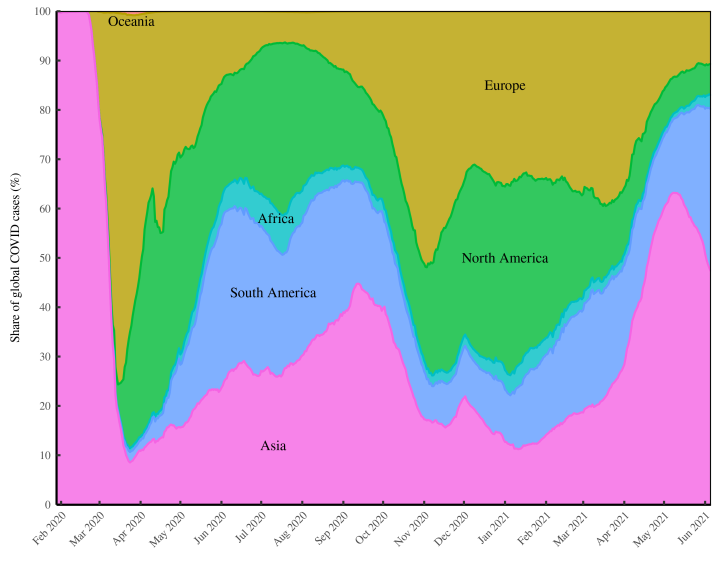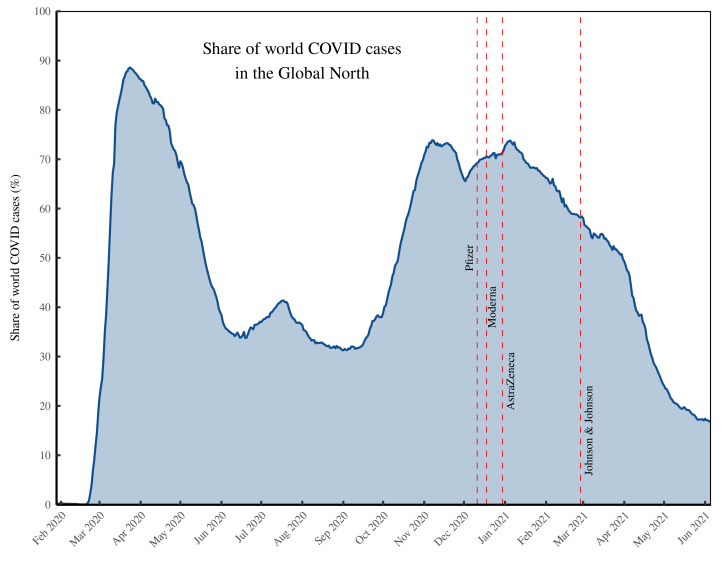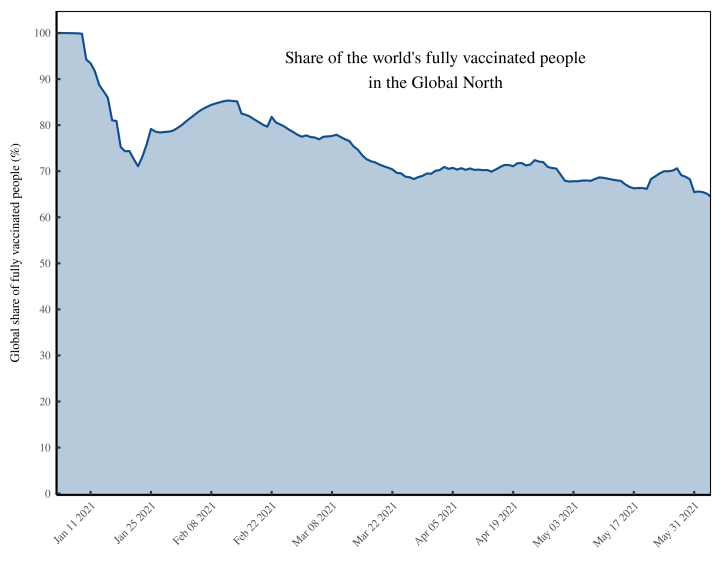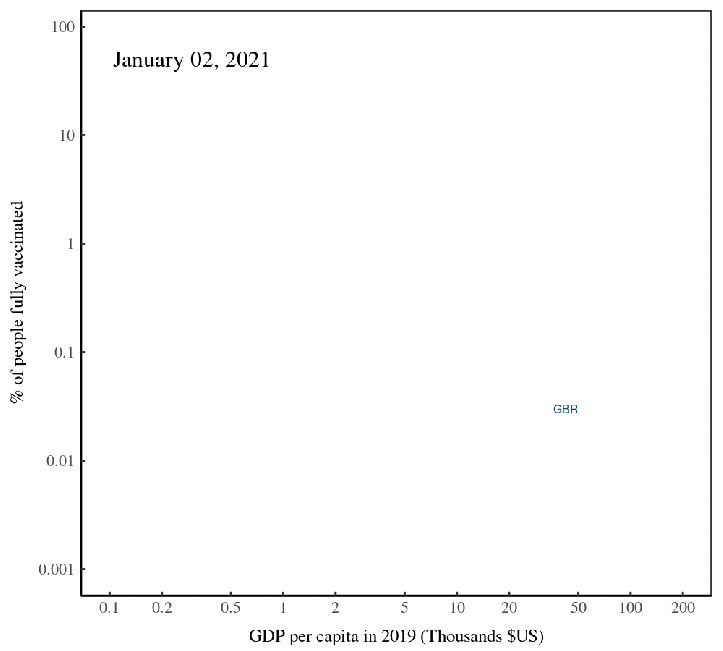From Blair Fix Around the world, rich countries are celebrating as their COVID numbers fall. Their success is no mystery — it’s because of a massive rollout of COVID vaccines. While we should celebrate the development of these vaccines, their deployment highlights the tyrannies of capitalism. Most of the basic research for COVID vaccines was funded by the public. Yet their manufacture is controlled by Big Pharma. The predictable result is that vaccines flow to the highest bidder and Big Pharma reaps the profit. Thus, the world is now ‘blessed’ with 9 new pharma billionaires. Since we’re stuck with COVID for the long haul, we need to end the privatized vaccine model. The alternative is surprisingly simple. Let governments continue to fund basic science. And let private companies
Topics:
Editor considers the following as important: Uncategorized
This could be interesting, too:
tom writes The Ukraine war and Europe’s deepening march of folly
Stavros Mavroudeas writes CfP of Marxist Macroeconomic Modelling workgroup – 18th WAPE Forum, Istanbul August 6-8, 2025
Lars Pålsson Syll writes The pretence-of-knowledge syndrome
Dean Baker writes Crypto and Donald Trump’s strategic baseball card reserve
from Blair Fix
Around the world, rich countries are celebrating as their COVID numbers fall. Their success is no mystery — it’s because of a massive rollout of COVID vaccines. While we should celebrate the development of these vaccines, their deployment highlights the tyrannies of capitalism.
Most of the basic research for COVID vaccines was funded by the public. Yet their manufacture is controlled by Big Pharma. The predictable result is that vaccines flow to the highest bidder and Big Pharma reaps the profit. Thus, the world is now ‘blessed’ with 9 new pharma billionaires.
Since we’re stuck with COVID for the long haul, we need to end the privatized vaccine model. The alternative is surprisingly simple. Let governments continue to fund basic science. And let private companies continue to manufacture vaccines. Just don’t let these companies have a monopoly on property rights. Instead, put vaccines in the Creative Commons. The result will be cheap vaccines, available to all.
To make the case for open-access vaccines, it helps to run the numbers. To date, the vast majority of COVID vaccines have gone to rich nations. It’s plutocratic healthcare in action: more money = more vaccines.
Let the data speak.
The global distribution of COVID cases
We’ll start by looking at how the global distribution of COVID cases has played out since the beginning of the pandemic. Figure 1 shows the global share of cases by continent since February 2020.

When the pandemic started in late 2019, Asia had 100% of all COVID cases — obviously because the virus arose in China. In March 2020, Donald Trump bemoaned the spread of the ‘Chinese virus’. But by then the vast majority of cases were in Europe, which had refused to lock down until it was too late.
After the early European (and then American) debacle, the spread of the virus slowed in these regions, but sped up in Asia and South America. By September 2020, the majority of cases were in the ‘Global South’. Then in the fall of 2020, the US and Europe brashly reopened and cases there skyrocketed. And so at the start of 2021, most COVID cases were again in the ‘Global North’.
Figure 2 shows this ‘North-South’ dynamic. I’ve plotted here the Global North’s share of world COVID cases since February 2020. (Remember that ‘North’ is code for ‘rich countries’. Here it consists of North America, Europe and Oceania.)

I’ve marked in Figure 2 the approval dates of the 4 major COVID vaccines. Shortly after these vaccines went on the market, COVID numbers in the Global North plummeted. Today, COVID is overwhelmingly a disease of the Global South. In other words, the pandemic is now a poor-country problem.
The global distribution of COVID vaccines
Let’s switch gears now and look at the global rollout of COVID vaccines. The most ethical way to distribute vaccines would be to send them where they are needed most. If we followed this principle, regions with the most cases would get the most vaccines. In other words, the vaccine rollout would mirror the COVID case load.
That’s not how things have played out.
COVID vaccines haven’t chased cases … they’ve chased dollars. As Figure 3 shows, vaccines have gone overwhelmingly to rich buyers in Europe and North America.

Figure 4 simplifies things by looking at the vaccine rollout in terms of a North-South dynamic. I’ve plotted here the share of fully vaccinated people who live in the Global North. In January 2021, when vaccines first rolled out in the UK and the US, this share was 100%. Thankfully, it declined thereafter, meaning some vaccines did make it to the Global South. But outside rich countries, the pace of vaccine distribution has been slow. As of June 4, 2021, 65% of all fully vaccinated people live in the Global North.

The truth is that the rollout of COVID vaccines has followed a simple plutocratic formula:
more money = more vaccines
My guess is that you can see this formula at many different scales. For instance, in Toronto (where I live) the vaccine rollout has been slower in low income neighbourhoods. And as we’ve seen above, at the global level vaccines have gone overwhelmingly to rich regions.
The same formula also holds at the national level, as shown in Figure 5 and 6. Across countries, the portion of people who are fully vaccinated is proportional to GDP per capita. In other words, the greater your income, the more vaccines you get.


If you’re familiar with global health statistics, the above trend won’t surprise you. Pick any health indicator (including other vaccination rates) and you’ll find that it gets better as per capita income grows. That’s because we live in a plutocratic world where money buys healthcare.
The truth about intellectual property
The unequal rollout of COVID vaccines brings me back to intellectual property. When drug patents expire, the drugs tend to become cheaper. Why? According to drugs.com, it’s because generic manufacturers have lower costs:
Generics are less expensive because the drug manufacturer does not have to duplicate the original clinical trials for effectiveness and safety, which lowers the cost to bring the drug to market.
Of course, it is true that generic manufacturers don’t do drug trials. But that’s not why drugs get cheaper when patents expire. The reality is that patented drugs are expensive precisely because they are patented. Drug patents are a government-sanctioned monopoly that gives the power to set prices. That’s the secret to Big Pharma’s thick profit margins (which tend to exceed the margins of most other companies on the S&P 500). Let the public fund the dirty work. Then get a monopoly on the final product.
Speaking of thick profit margins earned through intellectual property, perhaps the only firms that can compete with Big Pharma’s margins are academic publishers. In 2018, for instance, the publisher Elsevier reaped a profit margin of 37%. The reason academic publishers can compete with Big Pharma is because they’ve adopted the same business model:
- Let the public sector do the expensive basic science;
- In the last mile, put IP around the final product;
- Earn monopoly profits.
The key to these profits is intellectual property. It is the institutional fence that sanctions monopoly power. Without IP, Big Pharma’s hefty profits would vanish. That is the dirty truth that pharma execs dare not speak publicly. Instead, they’ll call their IP an ‘intangible asset’ that ‘generates value’. But inside the boardroom, Cory Doctorow notes, the doublespeak gets dropped. In the halls of power, ‘IP’ has a crisp meaning:
When you attune yourself to how businesses use “IP,” it has a very crisp meaning: “IP is anything that lets me control the conduct of my competitors, customers and critics.”
In other words, intellectual property is all about power. IP grants Big Pharma the power to restrict access to drugs. It’s no wonder that this power leads to unjust results. That’s what it’s designed to do.
Back to COVID vaccines. Big Pharma has been wielding IP for a long time, so there’s nothing new or surprising about the inequities of the COVID vaccine rollout. It’s just that the brutality of the pandemic makes these inequities more visceral. As a result, skepticism of drug IP is probably at an all-time high. A recent poll found that 85% of Americans oppose letting private companies have monopoly rights to vaccines.
Let’s put that skepticism to good use and end IP on all COVID vaccines. And when we’re done, let’s do the same for every other life-saving drug.
